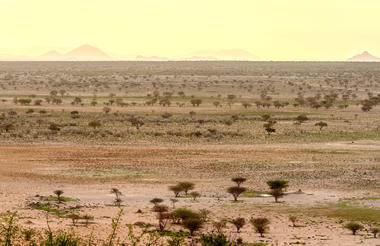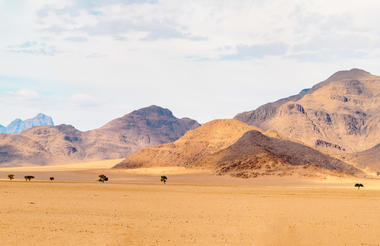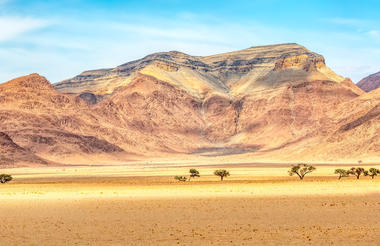Encompassing the bustling capital city of Windhoek, and the laid-back seaside towns of Swakopmund and Walvis Bay, Central Namibia features an array of towns, deserts, and wildlife reserves. The landscape of this region is characterised by grasslands decorated with clusters of Acacia trees, between the Namib Desert to the west and the lush Kalahari to the east. Visitors can soak in the steaming waters of the Cross Barmen Hot Springs, view a wide variety of wildlife, and explore the untouched beauty of the beautiful Erongo Mountains with the breathtakingly beautiful Spitzkoppe, which offers some of the best stargazing opportunities in the country. Divers and snorkellers will enjoy the incredible marine life just off the coast of Walvis Bay. Art lovers should make sure to visit the little town of Okahandja, famous for its fine wood carving and vibrant markets.
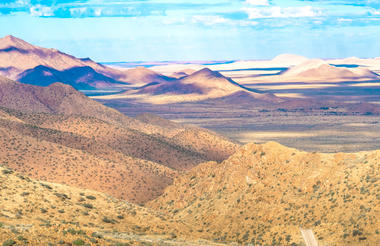
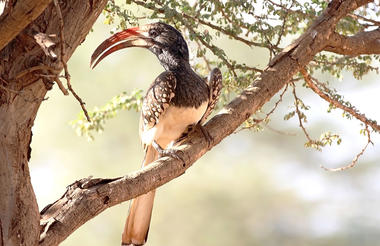
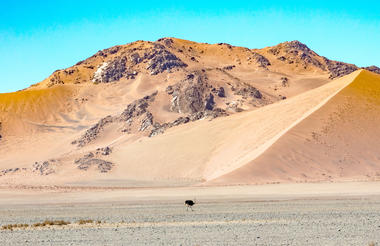
Northern Namibia extends across the remote Kunene River in the west of the country to the densely populated region of Ovamboland in the northeast. Central Ovamboland is part of Namibia’s extensive Kalahari system and is home to one of Africa’s largest game sanctuaries, Etosha National Park. The park provides phenomenal game viewing opportunities, and travellers can look forward to visiting the spectacular Etosha Pan. Damaraland lies to the northwest, with some of the most impressive rock art covering the rugged landscape. Further east, the Caprivi stretches for over 450 kilometres and is Namibia’s most tropical region acting as a corridor for African elephants moving through to Angola. Northern Namibia is a remote wilderness with incredible scenery, wildlife and exhilarating experiences, making it well worth the effort.
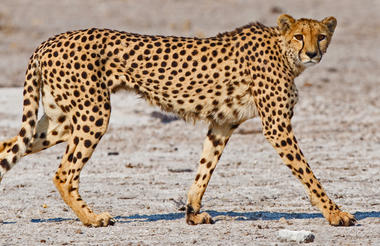
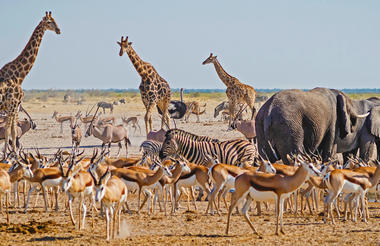
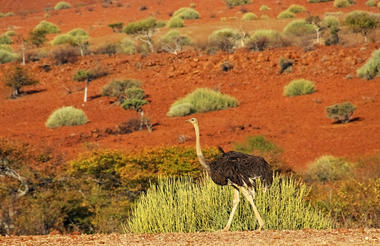
As previously described
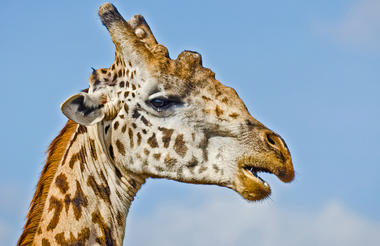

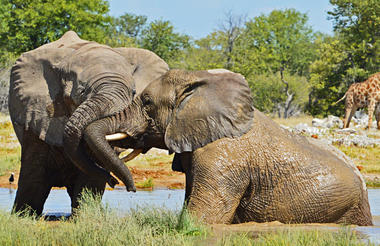
With its well-developed infrastructure, some of the best tourist facilities in Africa and an impressive list of breathtaking natural wonders, touring Namibia is truly a pleasure. Visit the capital of Windhoek and the lovely coastal town of Swakopmund to discover remnants of the country’s German influence, reflected in the architecture, culture, cuisine and the annual Oktoberfest celebrations. To properly appreciate this extraordinary country, you will have to venture out of the cities to explore the remarkable natural landscapes Namibia has to offer. These include: the impressive Fish River Canyon Park; the vast Etosha National Park teeming with local subspecies, such as desert lions, desert elephants and the Hartmann's Mountain Zebra; the hauntingly beautiful Kalahari Desert; and of course the Namib Desert stretching for nearly 1000 km along the magnificent Atlantic coastline. Namibia is an ideal destination for travellers seeking an unforgettable African experience in a uniquely beautiful untamed wilderness.
Money
Currency Namibia uses the Namibian Dollar (N$) this is linked on a one to one exchange with the South African Rand. The Rand is legal tender in Namibia, but the N$ cannot be used in South Africa.
Banking Banks are found in most towns, and are generally open from 09h00 - 15h30 during the week, and from 08h30 to 11h00 on a Saturday. Closed on Sundays and Public Holidays. Most offer foreign exchange services - with cash, bank and credit cards as well as travellers cheques.
You can also obtain cash from many of the ATM's, Several International Banks have branches in main City centres. Always advise your Bank that you are travelling outside of the country as they might block your purchases if they have not been informed.
Travel, Transport and Getting Around
Public transport in Namibia is geared towards the needs of the local populace, and is confined to main roads between major population centres. Although cheap and reliable, it is of little use to the traveller as most of Namibia's tourist attractions lie off the beaten track.
It is easy to travel around Namibia by car, and a 2WD vehicle is perfectly adaquate for most journeys. However, long distances, poor mobile phone coverage outside of main towns and infrequent petrol stations that only accept cash mean that planning ahead is vital.
There are major airlines that fly into Windhoek and Walvis Bay. Other destinations are reachable by car or Charter flight.
Namibians drive on the left and all signposts are in English. Seat belts must be worn at all times and talking on mobile phone while driving is prohibited. The general speed limit is 120km/h on tarred roads outside of towns and 100km/h on gravel roads. In built up areas, the speed limit is 60km/h.
Food, Drink and Cuisine Advise
Traditional Namibian cuisines is rarely served and so the food at Restaurants tends to be European in style and is, generally , of a very high standard.
Namibia is very meat-orientated, and many menu options will feature steaks from various animals. However, there is usually a vegetarian and seafood section offered by most Camps and Restaurants.
In Supermarkets you will find pre-wrapped fresh fruit and vegetables (though the more remote the areas you visit, the smaller your choice), and plenty of canned foods, pasta, rice, bread etc. Most of this is imported from South Africa.
The water in Namibia's main towns is generally safe to drink, through it may taste a little metallic if it has been piped for miles. Natural sources should usually be purified, though water from underground springs and dry riverbeds seldom causes any problems. However, filtered and bottled water are readily available in most towns and all Camps, Lodges and Hotels.
Climate and Weather
Partially covered by the Namib Desert, one of the World's driest Deserts, Namibia's climate is generally very dry and pleasant - it's fine to visit all year arround. Namibia's rain season is between December to March, some days will be humid and rain may follow, often in localised afternoon thunderstorms. These are more common in the centre and east of the Country, and more unusual in the Desert.
April/May are often lovely month in Namibia. Increasingly dry, with a real freshness in the air, and much greenery in the landscape.
From June to August Namibia cools down and dries out more, nights can become cold, dropping below freezing in some desert areas. As the landscape dries so the game in the north of the country gravitates more to waterholes, and is more easily seen by visitors.
By September and October it warms up again, game-viewing in most areas is at its best, although there's often a lot of dust arround and the vegetation has lost its vibrancy.
November is a hight variable month. Sometimes the hot, dry weather will continue, at other times the sky will fill with clouds and threaten to rain - but if you're lucky enough to witness the first rains of the season, you'll never forget the drama.
Clothing and Dress Recommendations
Namibians have a somewhat relaxed attitude to dress codes. A jacket and tie is very unusual. In fact, long trousers and a shirt with buttons are often quite adequate for a formal occasion or work wear. A pair of sensible shoes, jeans and a t-shirt is recommended.
During the day it is generally hot, so pack light weight loose fitting clothes in natural fabrics, such linen or cotton, that will keep you cool and are easy to wash and dry.
Avoid blue clothing - the tsetse flies are drawn to the colour blue, and their bite can give you African Sleeping Sickness
Long sleved shirts and long trouses will protect you against mosquitoes at night.
Electricity and Plug Standards
Current is 22/240 volts at 50 cycles per second. A three-point round-pin adapter plug should be brought for your electrical appliances. Such adapters are also available at major airports or local Supermarkets.
___________________________________________________________________________________

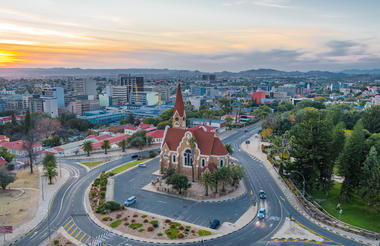

The Chobe River forms the northern boundary of the Chobe National Park, renowned for its reliable and diverse game viewing. Safaris are conducted both by boat and on land. This section of the park is best known for its elephant and hippo populations but the waters attract all manner of game including large herds of buffalo and the lions that prey on them.
As previously described
As previously described



Named by the Herero people after the spray it creates, Epupa Falls consists of a series of little waterfalls created by the Kunene River as it drops 60 metres, creating hundreds of natural pools that providing the Himba people and visitors with a fantastic recreation spot. The falls create a spectacular contrast to the arid desert and rugged surrounding mountains.
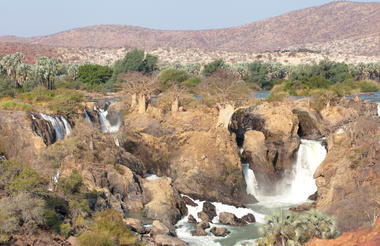
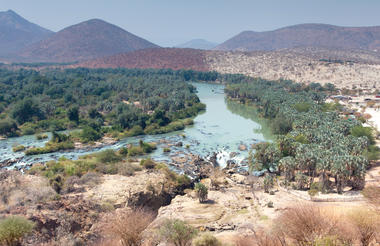
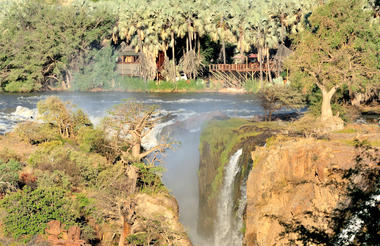
Damaraland is a captivating region in northwestern Namibia, characterized by its stark yet mesmerizing landscapes. Nestled between the Etosha National Park to the northeast and the Skeleton Coast to the west, Damaraland is renowned for its otherworldly scenery, where ancient red-rock formations and vast, open plains create a dramatic backdrop. The area is home to the iconic Spitzkoppe, a granite peak that stands as a symbol of the region.
Damaraland's charm extends beyond its geological wonders, as it is inhabited by desert-adapted wildlife, including elephants, oryx, and desert lions, uniquely adapted to survive in this arid environment. Visitors can also encounter the nomadic Himba people, who have maintained their traditional lifestyles and distinctive appearance over generations.
Exploring Damaraland offers a blend of cultural richness and natural beauty, making it a must-visit destination for those seeking an authentic and off-the-beaten-path Namibian experience.
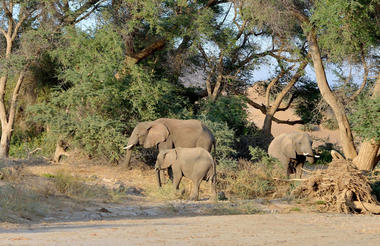
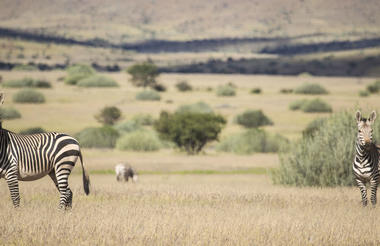
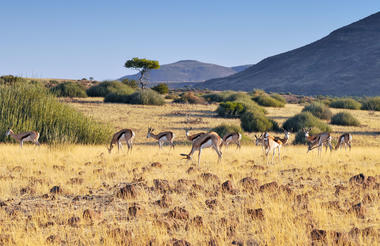
Founded in 1892 as the main harbour for German South West Africa, Swakopmund is often described as being more German than Germany. Now a seaside resort, Swakopmund is the capital of the Skeleton Coast tourism area and has plenty to keep visitors happy. The quirky mix of German and Namibian influences, colonial-era buildings and the cool sea breeze make it very popular.


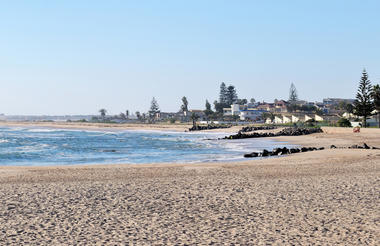
Walvis Bay (‘Whale Bay’) is a thriving town, Namibia’s principal harbour and one of the country’s most popular tourist centres, known for its natural lagoon, striking orange sand dunes and wealth of outdoor activities, including fishing, bird-watching, sailing, sandboarding, swimming, surfing and golf. Located just outside town is Dune 7, one of the largest sand dunes in the world, offering fantastic views from the crest for those with the energy to climb it.



As previously described
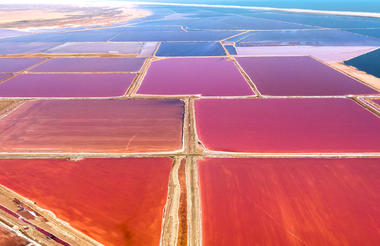


As previously described
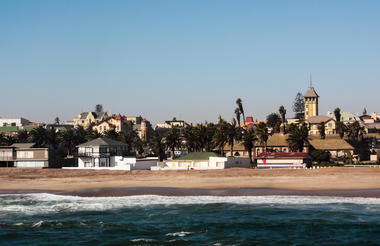
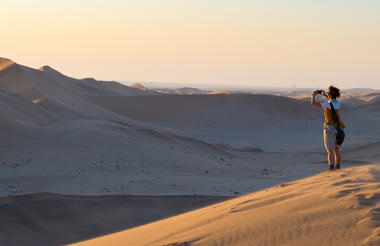
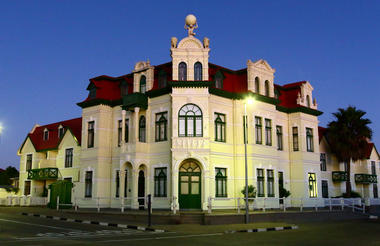
As previously described



Sossusvlei is where you will find the iconic red sand dunes of the Namib. The clear blue skies contrast with the giant red sand dunes to make this one of the natural wonders of Africa and a photographers heaven. Aside from the attractions at Sossusvlei - Dune 45, Hiddenvlei, Big Daddy and Deadvlei - other attractions in the area include the Sesriem Canyon and Namib-Naukluft National Park, where the mountains of the Namib meet its plains.
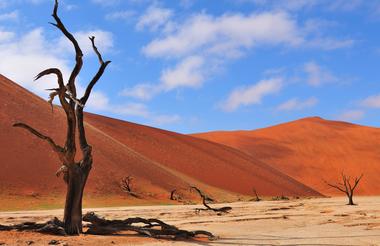
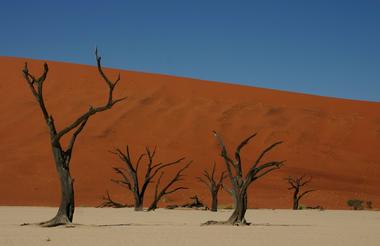
As previously described
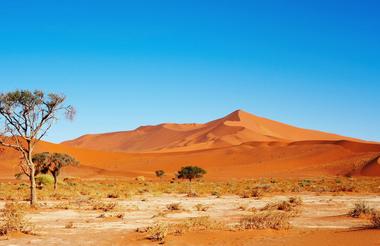
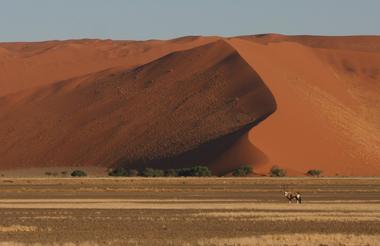
As previously described
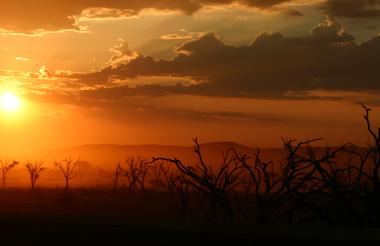

As previously described

Situated in southwestern Namibia at the edge of the world-renowned Namib Desert, the Tiras Mountains provide the perfect backdrop for visitors who venture to this red granite wonderland and immerse themselves in the natural beauty of this region. Namibian landscapes are synonymous with tranquility, serenity and endless open spaces and the magnificent Tiras Mountains encapsulate this quiet charm. Nature lovers flock here for an off-the-beaten-track experience in one of Namibia's most beautiful areas. Visitors can enjoy thrilling 4X4 mountain and dune tours, nature walks, game and bird viewing as well as excursions through quiver tree forests and to ancient rock paintings on granite rocks. Visitors can relax at one of the luxurious farm lodges after a wonderful day of activities, or get up close with nature while camping in this beautiful desert wilderness.



This seaside town is something of an anomaly – a piece of 19th century Bavaria bordering the pinkish sand dunes of the Namib Desert. Lutheran churches, German bakeries and colonial buildings are dotted about the settlement, while its windswept beaches are home to flamingos, ostriches, seals and penguins. The nearby ghost town of Kolmanskop is one of the most fascinating area attractions, located approximately 10 kilometres from Luderitz central.
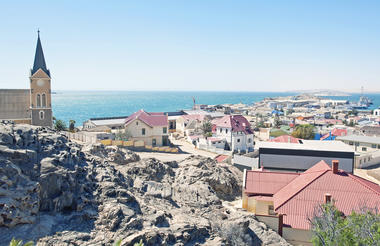
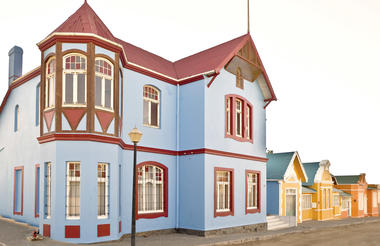
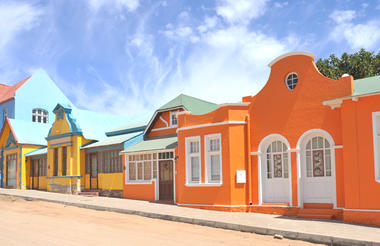
The intermittent Fish River has created Africa’s largest and the world’s second largest canyon. Hot, dry and stony the 160 km long, at times 27 km wide and 550m deep canyon is awe inspiring. At the southern end are the renowned hot springs of Ai-Ais.



Southern Namibia offers a harsh but beautiful environment stretching from the Orange River up to the Central Namibian highlands, Southern Namibia is epitomised by vast, slowly changing landscapes. The breathtakingly beautiful landscape features the Naukluft mountains, Namib desert dunes, and the Fish River Canyon. Southern Namibia is dotted with quiver trees, covered in golden grasslands, and crowned with burnt red dunes fringed by blue sky-lines. A spectacular array of wildlife roams freely including klipspringer, oryx and kudu. Visitors can soak up the breathtaking views of the Fish River Canyon, discover the wild desert horses near Aus, and explore the famous ghost town of Kolmanskop. Don't miss the ancient ochre dunes of Sossusvlei.



The Kalahari is an exceptionally beautiful living desert a large semi-arid sandy savannah draped over a gently rolling inland sea of sand covering most of Botswana and large parts of Namibia and South Africa. It is also the last bastion of the San people with the modern world having enveloped all the other areas they once roamed. Here in Namibia it is typically red sands covered in thin, wispy, mostly golden grass and dotted with acacia trees and wide ranging wildlife including gemsbok, impala, jackals and cheetah.
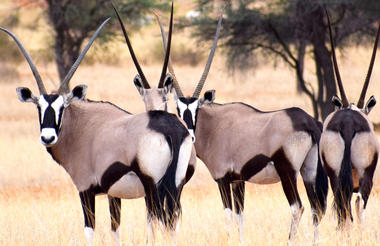
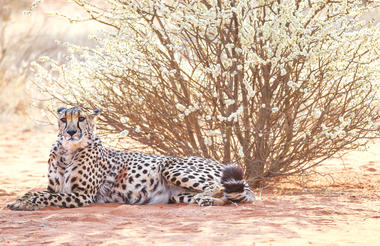

As previously described
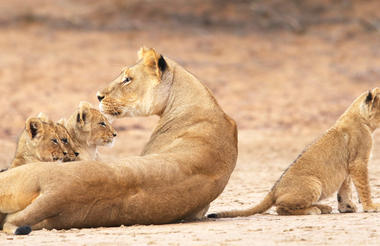
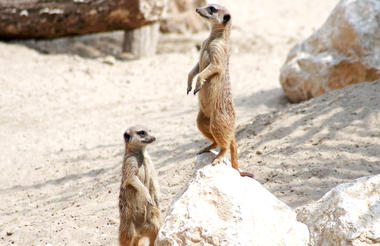

As previously described



As previously described
